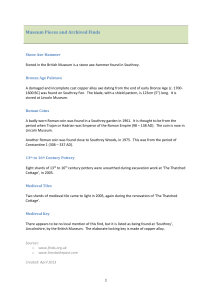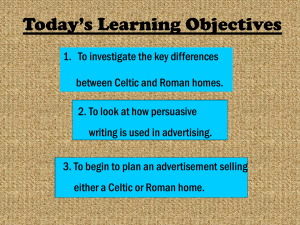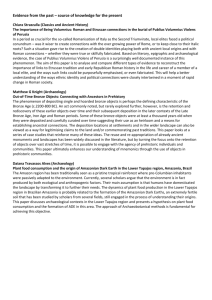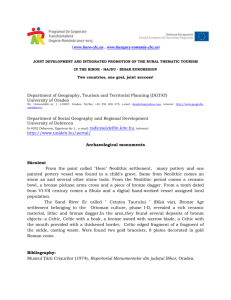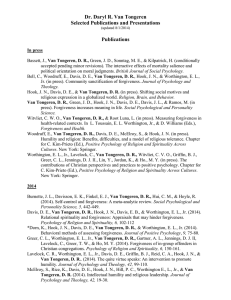Collection Gallo-Roman Museum - Gallo
advertisement
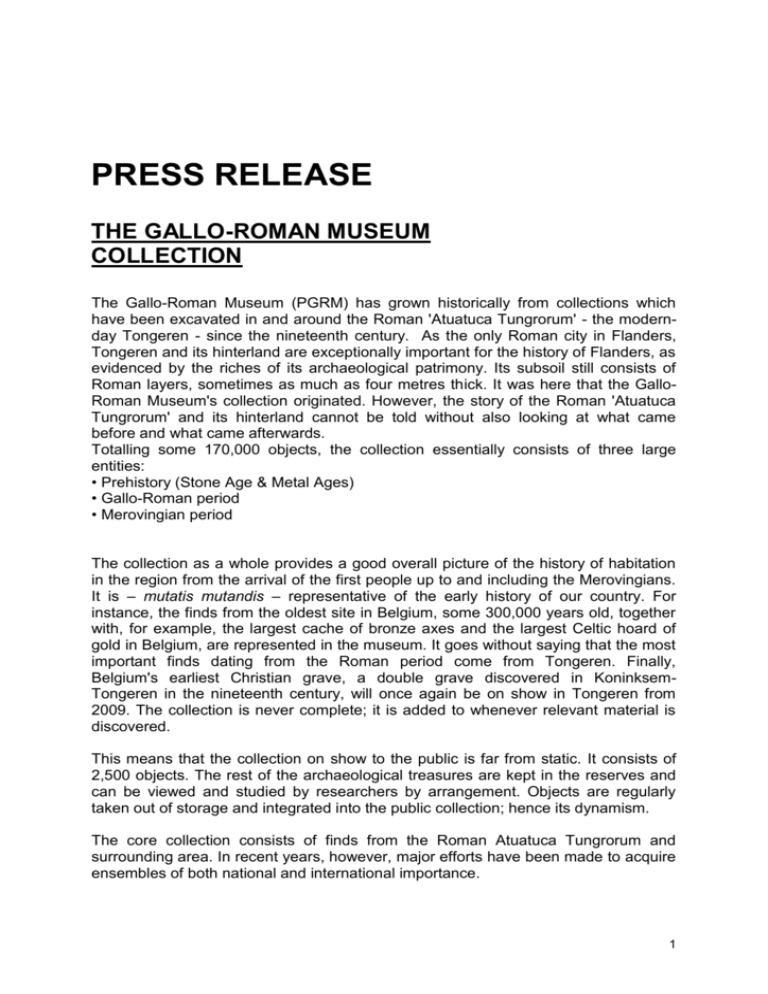
PRESS RELEASE THE GALLO-ROMAN MUSEUM COLLECTION The Gallo-Roman Museum (PGRM) has grown historically from collections which have been excavated in and around the Roman 'Atuatuca Tungrorum' - the modernday Tongeren - since the nineteenth century. As the only Roman city in Flanders, Tongeren and its hinterland are exceptionally important for the history of Flanders, as evidenced by the riches of its archaeological patrimony. Its subsoil still consists of Roman layers, sometimes as much as four metres thick. It was here that the GalloRoman Museum's collection originated. However, the story of the Roman 'Atuatuca Tungrorum' and its hinterland cannot be told without also looking at what came before and what came afterwards. Totalling some 170,000 objects, the collection essentially consists of three large entities: • Prehistory (Stone Age & Metal Ages) • Gallo-Roman period • Merovingian period The collection as a whole provides a good overall picture of the history of habitation in the region from the arrival of the first people up to and including the Merovingians. It is – mutatis mutandis – representative of the early history of our country. For instance, the finds from the oldest site in Belgium, some 300,000 years old, together with, for example, the largest cache of bronze axes and the largest Celtic hoard of gold in Belgium, are represented in the museum. It goes without saying that the most important finds dating from the Roman period come from Tongeren. Finally, Belgium's earliest Christian grave, a double grave discovered in KoninksemTongeren in the nineteenth century, will once again be on show in Tongeren from 2009. The collection is never complete; it is added to whenever relevant material is discovered. This means that the collection on show to the public is far from static. It consists of 2,500 objects. The rest of the archaeological treasures are kept in the reserves and can be viewed and studied by researchers by arrangement. Objects are regularly taken out of storage and integrated into the public collection; hence its dynamism. The core collection consists of finds from the Roman Atuatuca Tungrorum and surrounding area. In recent years, however, major efforts have been made to acquire ensembles of both national and international importance. 1 For instance, finds from the main Neanderthal camps (Veldwezelt and Kesselt) discovered around the end of the last century are on show in the Gallo-Roman Museum. Furthermore, in 1995 the King Baudouin Foundation reached an agreement with the rightful owners to purchase the most important cache of bronze axes in Belgium, known as the 'Bronze Heppeneert Cache', drawing on its Cultural Heritage Fund. That cache is now on loan to the Provincial Gallo-Roman Museum. In 1997 the PGRM, with the support of the Visual Arts Department and Museums of the Department of Culture (Ministry of the Flemish Community) was able to purchase the Beringen Celtic gold cache. In 2001 with the support of the Ministry of the Flemish Community, the PGRM acquired the Heers gold cache, known as the 'Treasure of Ambiorix': a collection of 94 Celtic gold staters (coins), including coins minted by the Eburones, the Nervians, the Trevierans and the Bellovaci. For the Gallo-Roman department, the PGRM was able to acquire an important gold ring with an intaglio of Emperor Commodus. A bronze balsamarium in the shape of a leather boot, together with five game pieces made of white glass paste were also purchased. This collection of grave-goods from the municipality of Hoeselt is quite extraordinary. To date we know of no more than five comparable finds in the whole of the Roman Empire. A lead staff bearing Emperor Tiberius' name which was discovered in Vermeulenstraat in Tongeren in 2008 can also be added to the new display. In 2006 a find of national importance, namely the early Christian tomb of Koninksem (Tongeren), was acquired for inclusion in the new public presentation. This grave is one of the most important early-Christian testimonies in Western Europe. Collection highlights: Heppeneert-Maaseik bronze cache (c. 8th-7th BC) This cache comprises 47 bronze axe-heads and a bronze spear-head, making it the largest find of its kind in the Benelux. Most of the axes were produced in Northern France (‘Plainseau culture') and date from the transition from the Bronze Age to the Iron Age. There is still no conclusive explanation for such finds. Most experts think they were ritual sacrifices to the gods. Interestingly, most of these types of find have been discovered close to water, near rivers or small meres. Wijshagen-Meeuwen-Gruitrode Celtic grave finds (c. 5th – 4th BC) These Celtic grave-goods were discovered during an archaeological dig in 1986 1987. The utensils, two ‘situlae’ (bucket-shaped vessels) and a ‘cista’(casket) were interred as urns in the burial mound of a rich tribal chief. They derive from the Mosel region and from Northern Italy and are typical of the Celtic culture. We don't know why the local tribal chiefs of Wijshagen had contact with the Celts. Perhaps they traded local products such as skins or cattle for prestigious Celtic objects. In the main area occupied by the Celts such objects were used for mixing wine with water in ritual ceremonies. 2 Beringen Celtic hoard of gold (end c. 2nd BC) These gold objects - various necklaces, a fragment of a bracelet and 25 coins - were found by chance when a house was being built. It is more than likely a ritual cache, even though we don't know which favour this offering sought from the gods. What is remarkable is that we know of ten such hoards throughout Europe with an almost identical makeup. Most of the coins are so-called ‘rainbow dishes’ from Central Europe. Several coins may be some of the earliest to be minted by the still young Eburone community. Heers Celtic coin cache (middle c. 1st BC) This find comprises 78 gold coins belonging to the Eburones, 21 to the Nervians, one to the Trevians and one to the Bellovaci. Found quite by chance in a field, it is the largest Celtic coin cache discovered in Belgium to date. There is a great temptation to link the finds to the uprising of the Eburone king Ambiorix against Julius Caesar's legions. With the help of other tribes, namely the Nervians and the Trevians, Ambiorix defeated two Roman legions in the winter of 54 – 53 BC. Balsamarium in the shape of a Nubian head from Vlijtingen-Riemst (c. 2nd) This balsamarium, a small container for ointment or oil, may derive from an impressive collection of burial gifts belonging to a Roman gentleman farmer. It must have been a strange sight for the local people who had only just come into contact with the Roman culture. The Romans were in fact responsible for introducing the local population to the wider world. In Mediterranean regions it was customary for African slaves to be put to work in the public baths. Hence, too, the balsamariumNubian connection. Tongeren Jupiter giant (c. 2nd) This sculpture of a horseman defeating a group of giants - terrifying creatures with the body of a snake - was excavated on the site of the former temple on the north side of Tongeren. In the Roman period it was the largest temple in the northern part of Europe. The horseman is holding several thunderbolts, and thus represents the god Jupiter. The giants are the sons of Mother Earth who rose up against the gods. The sculpture thus represents the victory of good over evil, but perhaps also the triumph of the emperor in his struggle against the 'barbarians'. Jupiter giant sculptures such as this one, which are found in the Benelux, in northern France and in south-west Germany, are a typical indigenous creation. Tongeren glass collection Hundreds of graves have been discovered outside the Roman city walls since the eighteenth century. In the Roman period there were two large necropolises, one on the south-west side of the city and another on the eastern side. The Tongeren graves are some of the richest in north-western Europe. The Gallo-Roman Museum has a particularly impressive collection of glass, the majority of the items deriving from richly-endowed graves. Tongeren had no glass production of its own. Most of the glass came from Cologne and was transported from there to Tongeren along the most important communication route in the north, the road from Cologne to Boulogne-sur-Mer. 3 Koninksem ‘early-Christian’ tomb - Tongeren (c. 4th) This tomb – actually a double grave – was discovered in a loam pit in 1880. The find came as a real bombshell. The walls of the tomb are decorated with magnificent paintings featuring garlands and doves - unmistakably Christian symbolism, or so it was thought at the time. In those days there was no archaeological museum in Tongeren and so the tomb was taken to Liège, then the episcopal see. Thanks to the cooperation of the ‘Trésor de la Cathédrale de Liège', in 2006 the Gallo-Roman Museum was able to bring the tomb back to Tongeren. For the first time in almost 130 years and after an intense restoration campaign, the tomb can again be admired in the place where it was discovered. The find played an important role in the discussion about the earliest Christinization of our country. We now know that the iconography on the grave also appeared in early, non-Christian graves, so the discussion about its Christian character is not yet closed and, indeed, is the subject of further research. 4
